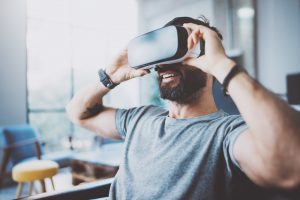As businesses navigated an unprecedented global pandemic, many were happy just to survive. Now, in a post-lockdown environment, companies are ready to grow again.
 They are ready to reach new customers while providing an even better experience for their existing users, allowing more people to enjoy their products, services, and platforms.
They are ready to reach new customers while providing an even better experience for their existing users, allowing more people to enjoy their products, services, and platforms.
In short, they are ready to innovate.
Linking Innovation and Sustainability
This may not occur as naturally as they hope. According to a McKinsey & Company analysis, “commitment to innovation has decreased as companies work through the COVID-19 crisis and focus on short-term issues.” In addition, the study found that only 21% of executives believe they “have the expertise, resources, and commitment to pursue new growth.”
Leaders can’t afford to be left behind. Interestingly, we’ve been here before. One study of business growth following the 2008 recession found that innovation and sustainability are inextricably linked, as the 20 most innovative brands grew at nearly twice the rate of the S&P 500. At the same time, innovative brands were associated with resilience and longevity. In other words, unlocking innovation is critical to achieving post-pandemic growth.
Meanwhile, many companies are operating remotely, making it more difficult than ever to build cohesion and foster communication and collaboration practices that can spur innovation. Virtual reality offers a solution, allowing disrupted teams to participate in immersive training and team-building exercises to develop strong teams that propel companies forward.
3 Ways Businesses Can Utilize VR
Here are three ways businesses can harness virtual reality to build stronger teams and spur innovation:
1. Build Better Connections
For many companies, embracing hybrid work arrangements means more meetings for everyone. A study conducted by Harvard Business School and New York University found that meeting volume increased by nearly 13% during the recent pandemic. Unfortunately, these meetings failed to improve operational outcomes, instead fostering ineffective collaboration and inefficient work practices that reduce productivity by up to 3%.
This trend has given rise to “Zoom fatigue,” a colloquial expression for the fatigue that follows seemingly endless and interminable online meetings. These meetings also fail to achieve their primary objective: building connections and facilitating collaboration. In fact, this environment is contributing to historic levels of turnover. According to the New York Times, “More people are beginning and leaving jobs without once seeing their colleagues face-to-face, leading to an easy-come, easy-go attitude toward workplaces.”
This phenomenon erodes productivity and stifles innovation. Businesses need to do better, and virtual reality offers a solution.
With virtual reality, hybrid teams can do more than have a conversation. They can share an experience and encounter the emotions associated with a particular event. This has profound psychological effects that are memorable and impactful.
Before the pandemic, business leaders tried to accomplish these often-elusive outcomes through corporate retreats and team-building exercises. Now, those experiences can be enacted digitally with virtual reality, allowing teams to perform everything from virtual ropes-course-style challenges to summiting Everest as they develop trust and forge lasting bonds that define strong, sustainable, and innovative teams.
2. Develop Innovation-Inducing Habits
Innovation isn’t an inherited trait. It’s a developed skill that businesses need to nurture. While studies abound on the specific traits that make people innovative and teams successful, companies can support innovation by teaching and supporting several core qualities, including:
- Becoming comfortable with discomfort
- Embracing new ideas with an open mind
- Forging ahead when the path is unclear
- Acknowledging that fear is an abstraction
- Relying on your team to support you if you fail
Innovation also requires people to adopt a particular mindset that inspires new ideas. At the same time, people have to be comfortable taking risks, knowing that they are as likely to fail as they are to develop a significant breakthrough idea.
Virtual reality can help facilitate a mindset and a framework to be innovative. With virtual reality, people can partake in experiences and adventures that would be practically impossible under normal circumstances. They can learn to take risks while they climb a mountain or walk the perimeter of a skyscraper, and they can be fortified by the real-time support of their colleagues and peers. Virtual reality enables people to grapple with complicated emotions while learning to overcome seemingly impossible obstacles—all from their living room or home office.
3. Maintain Training Over Time
Innovative teams won’t be developed overnight. Cultivating a workplace culture that drives innovation requires time and persistence, making one-off company gatherings an ineffective and inefficient way to support innovation.
Of course, flying disparate teams to remote locations with regularity is practically impossible and financially irresponsible. However, companies can send employees a $300 headset that enhances everyday meetings and more significant gatherings and events with virtual reality.
Time for a Change
It’s clear that Zoom happy hours and loosely defined Slack chats are not creating the cohesive, collaborative teams we want. It’s time for a change. Imagine the possibilities of team-building mini-golf to close a particularly challenging week or navigating a virtual escape room with in-house and distributed team members at once.
Like the last period of collective uncertainty, companies that innovate are businesses that survive and thrive. This won’t happen by accident, and virtual reality can help companies develop teams ready to meet the moment.
Marshall Mosher is the the Founder and CEO of Vestigo, as well as the host of the Inside the Adventure podcast. A world-record-holding action sport poly-athlete and tech futurist, Mosher brings his passion for adventure into the digital world by building the future of virtual reality adventure. His recent VR team programs include work for numerous enterprises and businesses, including Microsoft and the CNN Emerging Product & Platform team, among many notable brands.
